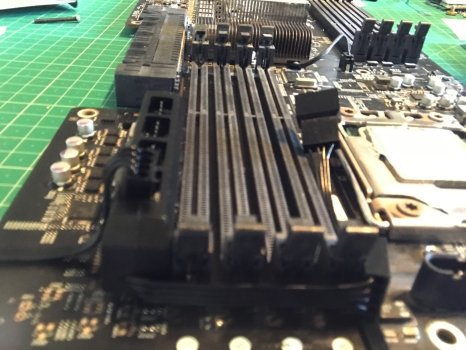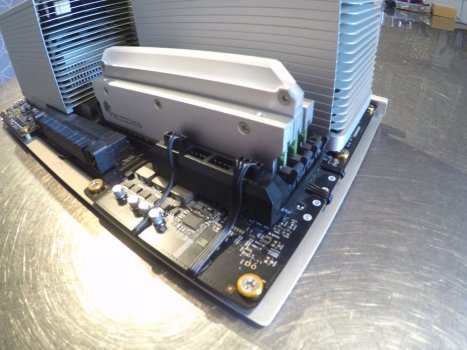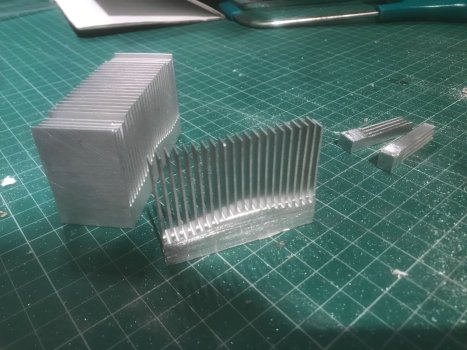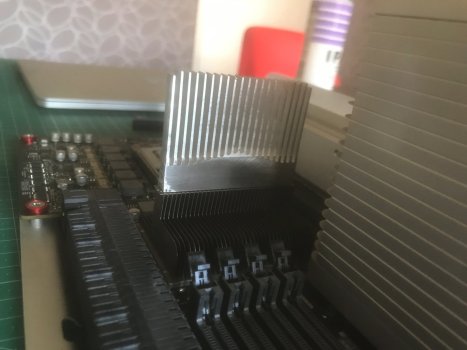Yep, there's no absolute truth lol
Vegas are known to be "a little noise" , yes
I switched exhaust back to auto and the temps are barely affected lol.
Yep, there's no absolute truth lol
Vegas are known to be "a little noise" , yes
I switched exhaust back to auto and the temps are barely affected lol.





Thankyou for posting, this is invaluable to all.I am kind-of late to the party here, however, I think this is the best place to make this post. I have a slightly tweaked approach to cooling the Northbridge that may be of interest to people going through this thread. This thread was of great use to me in my quest to bring my Northbridge temps down, so I thought I should contribute. I may make another post elsewhere still, as my modifications crossover into other territory a bit.
I completed the same and my investigations led me to believe that the Apple fan controller set up from factory complies with intel's max temp that seems why their thermal engineering team put that sub optimal heat sink on the NorthBridge upstream of the CPUA.
To start with, I upgraded my 2010 5,1 to two 3.46Ghz Xeon Processors. Things are fine there, but I noticed that the Northbridge was quite hot, (likely because of the upgrade), so I started to take steps to lower it. I de-dusted, replaced the Northbridge heatsink clips (with metal ones) and repasted. After all that the temp only came down a couple of degrees. It was running in the high 70s to low 80s.
I was able to get this result on Northbridge HeatSink Temp using a ghetto hack. I would be interested to compare to yours with a fan. Note this is My Heat Sink Temp, the Diode Temp is +11ºC and I think that is because the Apple Heatsink is Al not Cu or Au, It has crossed my mind to find some Cu shims to act as a heat spreader but bonding Cu and Al on a large surface is notoriously fiddly and thus probably fruitless.
I fiddled with Mac Fans Control, and that helped a little, but to bring down the temp significantly required the fans to really be blasting, so I gave up on that approach for the most part.
Thanks for the Link I haveThen I started adding in mini fans. I tried 5 different fan sizes, ranging from blower types, to tiny 3cm fans. Testing with those, the 4cm fan came out on top for cooling, though the 5cm was close, and much quieter. For now I am using the 4cm fan (10mm thick). The thinness helps in getting the fan to point down on the bulk of the heatsink.
However, I didn't like the cables running off the mainboard. (It even caused a bent pin in my processor/mainboard connector once!) I got a great idea from this thread Mac Pro (4.1/5.1) aftermarket fans WITH automatic SMC control
and had power running from a splitter hooked into intake fans 4pin header.
I am wondering if you have measured the Total A draw on the SMC ?
This lead me to my next idea, which was to run a splitter off of the booster fan header. However, it is a, I think, proprietary, 6 pin header. Thanks again to the posters and info in the thread mentioned above, I was able to splice in a fan hub to power the fan 'on' the processor board, via the booster fan header. That should reduce the cable issues.
Really good idea, I like the elegance of finding a way to extend the heat sink fins. Did you mechanically bond the fin - fin contact ? I l looked around for a similar solution but no one is selling their norrth bridge heat sinks ( yet ) in favour of fancy AIO water loops.I went one step further and added an extension to the heatsink itself. I noticed a small space between the part of the heatsink that extends into the processor heatsink, and the fan, and so I hacksawed a slice of an old heatsink and slid it into the top of the Northbridge heatsink. You wouldn't think it would work, but it did, dropping temps between 3-6 degrees.
Hacksawed a slice of heatsink...
View attachment 2048028
Added it to the heatsink (flipped it upside down in the final version, fitting the fins into the Northbridge heatsinks fins)
The final result is I have a 4cm x 10mm fan mounted against the Northbridge heatsink, powered from the processor board itself. The Northbridge (diode) temps have been reduced from high 70s and low 80s to high 50s and low 60s. About a 20degree drop overall. And this is in high summer where I am, so winter might yield even better results (started this project in the winter, so original high temps were derived from there).
Thankyou for posting, this is invaluable to all.
I was able to get this result on Northbridge HeatSink Temp using a ghetto hack. I would be interested to compare to yours with a fan. Note this is My Heat Sink Temp, the Diode Temp is +11ºC and I think that is because the Apple Heatsink is Al not Cu or Au, It has crossed my mind to find some Cu shims to act as a heat spreader but bonding Cu and Al on a large surface is notoriously fiddly and thus probably fruitless.
View attachment 2065327
I am wondering if you have measured the Total A draw on the SMC ?
Fans consume power in an unusually expensive way following a set of relationships with power essentially = cube of the speed of the fan. Of course this is a multi dimensional problem so If you have been measuring the power that is the easiest way to see how much additional work and there for air is moving. It may also forestall a Baseboard power issue if you're pulling to much on the SMC circuits.
Really good idea, I like the elegance of finding a way to extend the heat sink fins. Did you mechanically bond the fin - fin contact ? I l looked around for a similar solution but no one is selling their norrth bridge heat sinks ( yet ) in favour of fancy AIO water loops.
I would and I am sure the other posters would like to see your longer term results.
iStatMy pleasure. It's nice to show the work to people who might care to see it. (My wife does not)
What app are you using to get the graph? I could do the same for mine to compare. I can predict though, based on my casual tests, that mine will run slightly hotter than that, though without any tweaking of the fans with MacFansControl (which I think you are using?)
No, no measuring of any kind. I just went for it. Though I did test it out in stages, and did some stress testing after installation. I was worried that the extra 'draw' on the mainboard might be an issue. However, I have run the fans at full bore, with 2 attached fans and the RGB controller all attached running at full speed/power, several times now, for a goodly amount of time, and have had no issues at all. So far...
It was some work to cut that heatsink. I did use some er..Grizzly thermal paste to attach/connect the fins. So some decent heat transfer there I think. They are also pressing against each other very tightly. It's a little unstable though, and it would have been nice to weld it together slightly.
I'll certainly post back here in a few more weeks/months, good or bad.
Also, I have to modify my post above, as I was off by 10mm on the fans. I am using 50mm fans, as they were the ones working best. So my previous post should have 10mm added to the size of each of the mentioned fans.
Apologies for that.
Excellent- I would love to see a bit more detail on how you connected the fan in from the booster fan power.View attachment 2068974
There are my temps on the Northbridge Heatsink last night. As I thought, a few degrees above yours. This was with my 5cm fan mounted.
Excellent- I would love to see a bit more detail on how you connected the fan in from the booster fan power.
Well Intel's design may have been great for system like the IBM X346 that lived in a cushy 19ºC Data centre bac kin 2004 But our CMP's generally live under a desk. So 90ºC Design spec is just not how some of us want it. Yes you are right we are obsessed, otherwise we would all have moved on to the MacPro new platformWow, this obsession with NB temperature. NBs are designed for/known for running hot (90°C is nothing special).
Yes and No, redirecting over the NB Heatsink is generally the goal IF you choose to run cooler NB.All you guys are doing is redirecting/obstructing the airflow by placing anything in between, causing the fans to run faster and have more noise for the same airflow.
Yes and isn't the whole inside of the case EMC noisy ?Placing a cheap fan generating lots of EMC noise above the RAM doesn’t seem to be a good idea either.
Yes Absolutely still need to hygiene and of course more fan speed / fans = more dust intake, in general terms.If the NB really runs hot, clean the dust out.
This is how we all started the journey, Kernal panics and mystery shut downs lead to troubleshooting and one of the common CMP problems is overheating NB chipsets. Which is why we are here obsessing about it.If this doesn’t help, reapply good quality thermal paste.
First time I've heard that but as it turns out I have have changed my PS and it removed some ongoing issues with my configuration.If this still doesn’t help, try another PS as the caps in it may have gone bad (NBs need clean power!).
Time's changed. Northbridges just run hot, I've seen so many servers have their NB's running at 100ºC with zero problems.Well Intel's design may have been great for system like the IBM X346 that lived in a cushy 19ºC Data centre bac kin 2004 But our CMP's generally live under a desk. So 90ºC Design spec is just not how some of us want it. Yes you are right we are obsessed, otherwise we would all have moved on to the MacPro new platform
There's more than just the NB. Redirecting flow to the NB means less flow elsewhere. In general, more obstructions means less flow in, less flow out, easy as is.Yes and No, redirecting over the NB Heatsink is generally the goal IF you choose to run cooler NB.
Far from noisy as EMI near the wires of the fan. When you look at the PC designs you'll never see fan-power traces nearby high-speed digital lines.Yes and isn't the whole inside of the case EMC noisy ?
Are these kernel panics and mystery shutdown linked to the NB? As long as the NB was within spec (5-104ºC, see attachment), you shouldn't have had issues. What temp did you NB get?This is how we all started the journey, Kernal panics and mystery shut downs lead to troubleshooting and one of the common CMP problems is overheating NB chipsets. Which is why we are here obsessing about it.
Yes, NB may run hot when the PS is bad. A bad PS actually leads to lots of weird issues. So the combination of the hot NB and issues you described leads me to think your PS is bad. I actually replaced one from my working machine recently. Especially with the power hungry X5690s and the modern graphic cards a good PS (or even recapped) is key for a stable system.First time I've heard that but as it turns out I have have changed my PS and it removed some ongoing issues with my configuration.
Unfortunately, quite a few users experienced stability issue when the NB diode temperature reported above ~90°C.Are these kernel panics and mystery shutdown linked to the NB? As long as the NB was within spec (5-104ºC, see attachment), you shouldn't have had issues. What temp did you NB get?
Where is the NB diode on the MacPro situated? Is it near the die? Maybe the thermal paste wears off causing the diode to measure the wrong temperature and not transferring the heat sufficiently to the heatsink (so actually the NB die gets much hotter than the diode temperature reading).Unfortunately, quite a few users experienced stability issue when the NB diode temperature reported above ~90°C.
I am with the single processor cMP. So, no NB temperature. Just keep the heatsink clean, and spin up the fans a bit, than the NB will stay below 50°C.
But for those dual processor cMP with a few NVMe installed. It seems the NB can go really hot and at some point, de-stablised the cMP.
Not sure. I think the diode is a part inside the chip.Where is the NB diode on the MacPro situated? Is it near the die? Maybe the thermal paste wears off causing the diode to measure the wrong temperature and not transferring the heat sufficiently to the heatsink (so actually the NB die gets much hotter than the diode temperature reading).
iStat reported 1.11V- what's the NB voltage reading (can we actually read it)?

